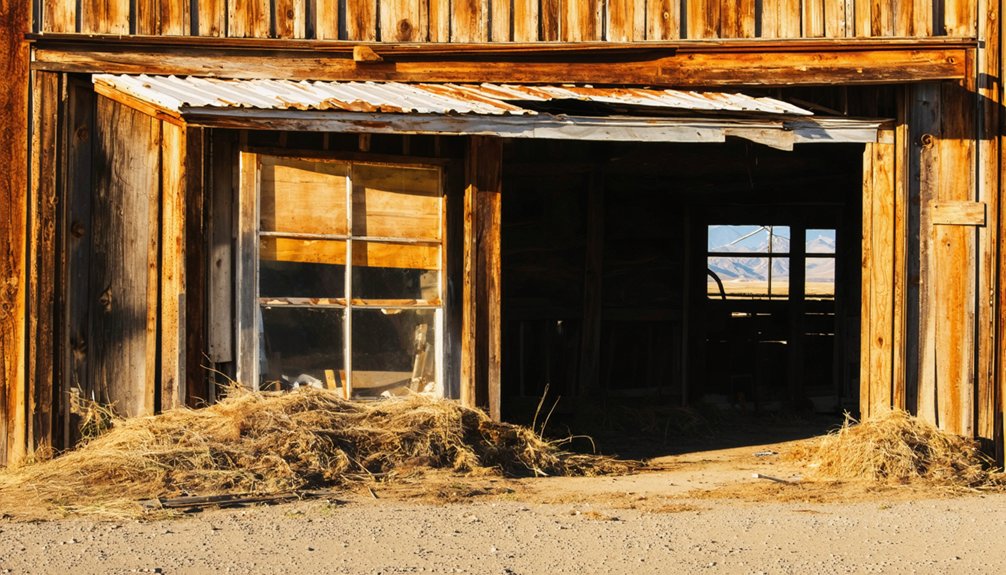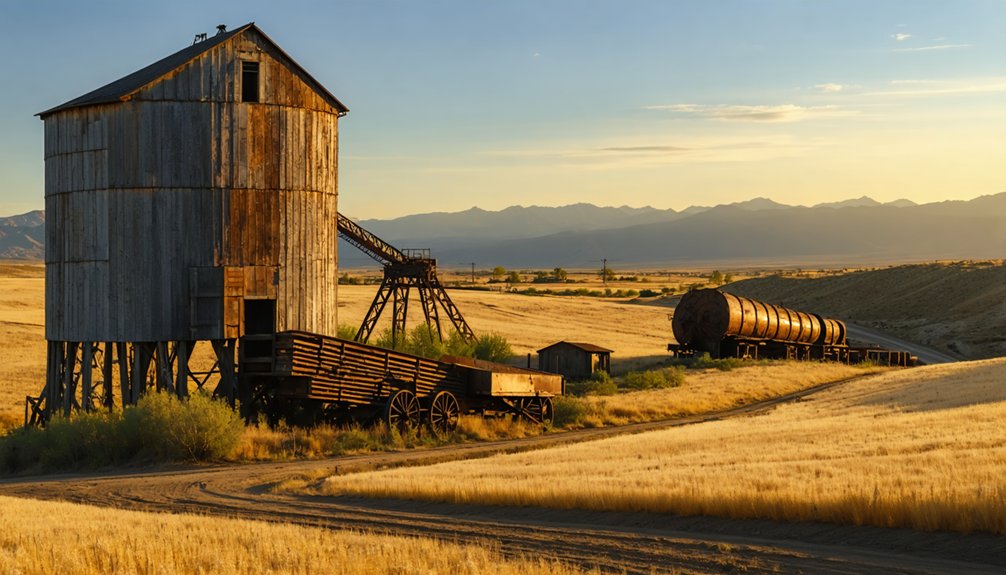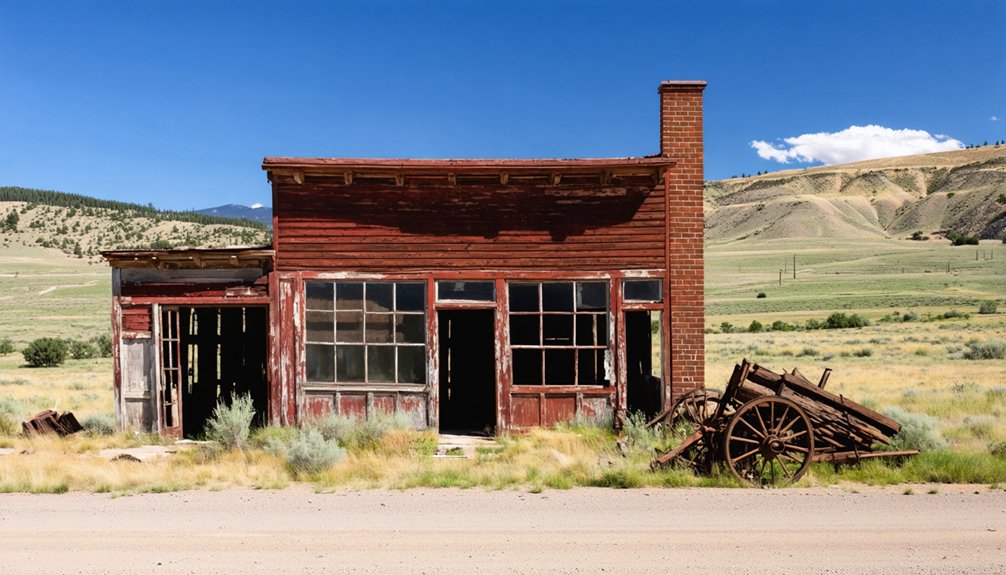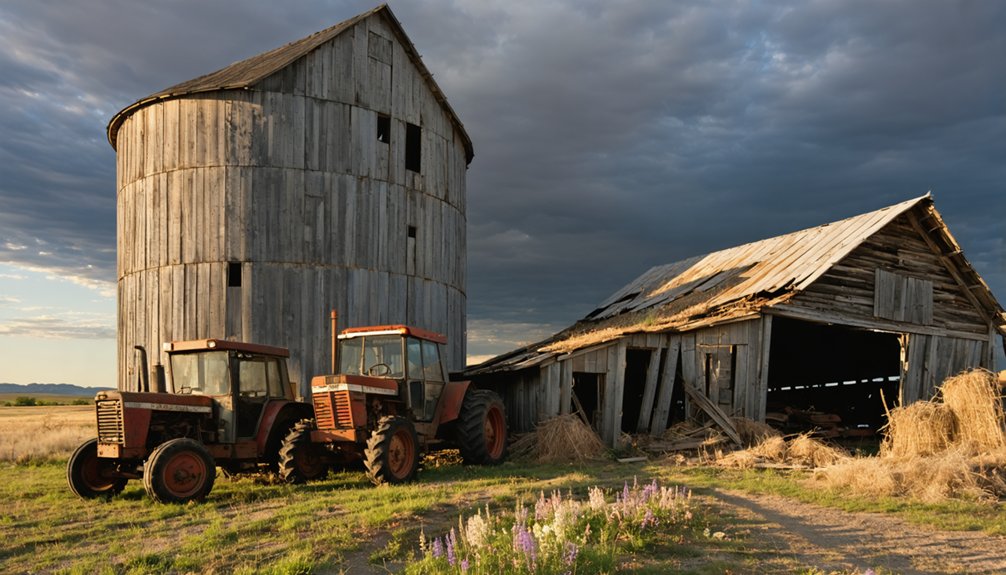You’ll find Herbert’s weathered remains along an old creek bed in eastern Idaho, where this early 1900s farming settlement once bustled with 150 residents. The ghost town’s two-room store and lone schoolhouse still stand as silent witnesses to the homesteading era, while foundations mark where families carved out lives through agriculture and small-scale mining. Today, the site’s deteriorating structures tell a compelling story of pioneer ambition and inevitable change.
Key Takeaways
- Herbert, Idaho was an early 1900s agricultural settlement that reached its peak with 150 residents before declining in the 1940s.
- The ghost town features remaining structures including a weathered two-room store and a lone schoolhouse along a creek.
- The community was built around farming and mining activities, supported by the construction of the Peoples Canal in 1894.
- Many original buildings were relocated to Arco after abandonment, leaving only foundations and six original homes along the creek.
- The site is accessible via rural roads from Rexburg, but visitors should prepare for challenging terrain and take safety precautions.
The Rise and Fall of a Farming Community
Although Herbert, Idaho began as a promising agricultural settlement in the early 1900s, its destiny followed a path similar to many small farming communities of the era.
At its peak, you’d have found about 150 residents living along the creek, supported by a two-room store perched on a bluff and a modest schoolhouse serving local families. The hardworking population consisted primarily of farmers and miners.
Life thrived in Herbert, with 150 souls sharing their days between the hilltop store and small schoolhouse.
The community’s decline accelerated when automobiles transformed rural life in the region. You could suddenly drive to larger towns like Rexburg or Rigby for better opportunities and services. The two-room building still stands as the first visible structure when entering the ghost town.
This rural migration, combined with the challenges of small-scale farming and limited agricultural technology, gradually emptied Herbert. By the 1940s, families had abandoned their creek-side homes, leaving behind fragile structures that stand today as silent witnesses to a once-thriving farming community.
Life in Early Herbert
Life in early Herbert reflected the determined spirit of Idaho’s pioneer farming families. You’d have found a tight-knit settlement of about 150 residents, where community bonding centered around the local schoolhouse and general store along the creek.
Daily life revolved around agricultural practices, with families working together to overcome the challenges of isolated frontier living. The construction of the Peoples Canal in 1894 transformed the once-barren landscape into productive farmland. Much like throughout Owyhee County, families engaged in experimental farming to test which crops would thrive in the challenging terrain.
You would’ve experienced the self-sufficiency that marked these early settlers, as they developed ways to sustain themselves through local resources.
The town’s Mormon cultural influences shaped social gatherings and family values, while the schoolhouse served as both an educational center and community hub.
Despite limited social services, neighbors relied on each other, creating informal support networks that helped them weather agricultural uncertainties and transportation difficulties.
What Remains Today
When you visit Herbert today, you’ll find a weathered two-room store perched on a bluff and a lone schoolhouse as the main standing structures.
The store’s second story, accessed by a narrow stairwell, features weakened floorboards that tell the story of decades of abandonment. The town thrived with a peak of about 150 residents before automobiles changed rural life. Most of the original buildings were moved to Arco when the town was abandoned.
Along the creek, you can spot the remains of about six original homes, though they’re hidden from the road and sit on private farmland.
Standing Structures Today
Today, the once-bustling town of Herbert stands as a sparse collection of weathered structures on private land, offering glimpses into Idaho’s pioneer past. Similar to the Old Idaho Penitentiary, many visitors report unexplained phenomena in the abandoned buildings.
As you explore the remnants, you’ll find a notable two-room store perched on a bluff off the main road, featuring a second story accessible by a narrow stairwell. While most buildings are hidden from view, several old homesteads dot the landscape along the creek. Thanks to Idaho’s arid climate conditions, many original structural elements have remained relatively well-preserved.
Following exploration guidelines is vital, as the buildings’ conditions have deteriorated considerably over time.
You’ll need to navigate carefully through private property, watching for barbed wire fences and active cropland. The store’s floorboards have weakened or broken in places, making careful navigation essential for your safety.
Original Layout Still Visible
Standing as a tribute to early 20th-century rural life, Herbert’s original layout remains remarkably discernible through its surviving structures and foundations.
You’ll find the prominent store building perched atop a bluff, overlooking what was once a bustling community of about 150 residents.
Archaeological findings reveal the town’s careful planning, with foundation outlines marking the schoolhouse and six homesteads scattered along the creek below.
Most residents eventually moved to nearby cities like Rexburg and Rigby as the town declined.
The layout features reflect the practical needs of early settlers, who positioned their homes near water sources for farming and daily use. Much like gold discovery in 1862 transformed Idaho City into the largest population center in the Northwest, Herbert’s strategic positioning helped shape its development.
While you’ll need to navigate private farmland and fences to explore the site, you can still trace the town’s footprint through cellar holes, chimney remains, and other structural remnants that dot the landscape.
Finding Your Way to Herbert
The journey to Herbert begins in Rexburg, Idaho, where you’ll head south along rural roads into the agricultural heartland.
For ghost town exploration enthusiasts, rural navigation through this region requires careful planning, as many roads remain unpaved and unmarked. You’ll find yourself traveling through expansive farmland that characterizes this part of southeastern Idaho.
While there aren’t any designated trails leading to Herbert’s former location, you can access the area by car. Look for the creek that once served as the town’s water source – it’s a helpful landmark for orientation.
Keep in mind that most structures have long since vanished, and what remains lies on private agricultural land. Consider bringing a detailed map, as GPS coverage can be spotty in these remote sections.
Seasonal Visiting Tips

You’ll find the best window for exploring Herbert’s remnants spans from late spring through early fall, when dry conditions make the terrain more manageable and structures safer to examine.
Winter’s heavy snowfall blocks access to the site and creates treacherous conditions on the narrow gravel roads leading to the ghost town.
For the most rewarding visit, plan your trip during summer’s warm days or fall’s crisp weather, but remember to check local forecasts since Idaho’s mountain weather can shift dramatically.
Best Times to Visit
When planning your visit to Herbert Ghost Town, timing can greatly impact your experience in this historic Idaho settlement. Late spring and early fall provide ideal conditions for historical exploration, with comfortable temperatures and fewer crowds to interrupt your journey through time.
You’ll find summer’s long daylight hours perfect for seasonal photography of the old schoolhouse and iconic two-room store.
Avoid winter visits, as heavy snowfall can make Herbert’s remains difficult to access. Spring brings vibrant renewal to the landscape, while fall treats you to a backdrop of changing colors that frame the abandoned structures beautifully.
Always check the weather forecast before heading out, as conditions can change quickly in this part of Idaho, and you’ll want clear skies to fully appreciate the remnants of this once-thriving farming community.
Road and Weather Safety
Before setting out for Herbert Ghost Town, make certain your vehicle is properly equipped for the challenging terrain and unpredictable weather conditions that characterize this remote Idaho destination.
You’ll need to check Idaho’s road conditions by calling 1-888-IDA-ROAD or visiting the 511 website, as the gravel roads leading to Herbert can become treacherous. During winter months, snow and ice create additional weather hazards, while spring rains can turn dirt paths into muddy obstacles.
Pack emergency supplies, including water, food, and a first-aid kit.
When traversing the property, watch for barbed wire fencing and unstable building structures. The old store’s deteriorating floorboards demand particular caution.
Since you’ll be crossing private farmland, respect property boundaries and consider seeking local guidance for the safest access routes.
Architectural Legacy
Although Herbert has largely faded into Idaho’s history, its architectural legacy endures through a handful of weathered structures that tell the story of early 20th-century rural life.
The historical architecture reflects a practical approach to community design, with a two-room store perched strategically on a bluff overlooking residential homes clustered along the creek below.
You’ll find simple wood-frame construction throughout the remaining buildings, featuring local timber and basic carpentry.
The homes and store used economical materials like shake roofs and board-and-batten siding, while some walls were insulated with magazine pages – a common frontier practice.
Today, these structures stand as fragile reminders of rural Idaho’s pioneering spirit, though their deteriorating conditions demand careful exploration of the weathered floorboards and unstable stairways.
Mining and Agricultural Heritage

Herbert’s dual identity as a mining and farming settlement shaped its brief but significant existence in early 20th-century Idaho.
You’ll find that mining techniques remained relatively small-scale here, with residents extracting minerals while simultaneously working the surrounding farmland. The community’s agricultural practices centered on irrigated crops, particularly hay production, taking advantage of the nearby creek’s water supply.
At its peak, you could’ve found 150 people living here, their lives intertwined through shared labor in the mines and fields. The town’s two-room store served as both a trading post and social hub, where miners and farmers exchanged goods and news.
But when automobiles made larger towns more accessible, you’d have witnessed Herbert’s gradual transformation from a bustling community into the quiet ghost town it’s today.
Safety Precautions for Explorers
Exploring Herbert Ghost Town requires serious attention to safety, as its weathered structures and mining legacy present multiple hazards.
You’ll need to bring proper exploration gear, including first aid supplies, navigation tools, and recovery equipment suitable for rough terrain. Since much of Herbert sits on private farmland, you’ll want to secure permissions and follow legal guidelines to avoid trespassing issues.
Don’t test old floorboards or staircases – stick to main support beams when necessary. Watch for toxic residues common in mining areas, and never enter mine shafts or tunnels.
Keep your hands clean and avoid eating or drinking while exploring. If you’re heading out solo, make sure someone knows your plans.
Historical Significance in Madison County

When you explore Herbert’s history in Madison County, you’ll find a typical early 20th-century farming settlement that grew from pioneer roots into a bustling community of 150 residents.
You can trace the town’s economic foundation to its strategic position between mining operations and fertile farmland, which supported both agricultural families and miners seeking precious minerals in the surrounding areas.
The town’s crucial services, including its two-room store perched on a bluff and its schoolhouse along the creek, served as essential community gathering points until automobiles made larger towns like Rexburg more accessible in the 1930s and ’40s.
Early Settlement and Growth
Located approximately 10 miles south of Rexburg in Madison County, the small farming community of Herbert emerged during the late 19th century as pioneers sought fertile agricultural land in southeastern Idaho.
The settlement patterns followed typical homesteading practices, with families establishing farms along a creek while building simple homes away from the main road.
As agricultural practices took root, Herbert’s population grew to around 150 residents.
You’d have found a bustling two-room store perched on a bluff, serving as the town’s commercial hub, while a schoolhouse provided education for the farming families’ children.
The community’s economy wasn’t solely dependent on farming – some residents supplemented their income by working in nearby mines, creating a diverse rural economy that supported the town’s growth through its early years.
Mining and Agricultural Impact
Unlike many Idaho ghost towns that sprang up around mineral strikes, Herbert’s historical significance stemmed primarily from its agricultural foundation rather than mining activity.
You’ll find that while some residents supplemented their income through small-scale mining methods, the town’s economic backbone was firmly rooted in farming.
The agricultural practices centered around the creek, where up to 150 residents cultivated the fertile Madison County soil.
You can still see evidence of their former fields today, some of which remain in active use.
While neighboring communities boomed and busted with mineral discoveries, Herbert maintained a steadier existence through its farming focus.
This agricultural stability couldn’t ultimately overcome the impact of automobiles, which made larger towns more accessible and eventually led to Herbert’s abandonment by the 1940s.
Community Life and Services
Though small in size, Herbert’s community life revolved around its essential services: a two-room general store perched on a bluff and a modest schoolhouse that educated local children.
You’d find families living in simple homes along the creek, fostering a tight-knit atmosphere where everyone knew their neighbors.
The local economy centered on farming and mining, with the general store serving as both a supply hub and informal gathering spot.
Without a post office, church, or medical facility, residents relied heavily on each other and occasional trips to Rexburg or Rigby for additional needs.
Community gatherings typically coincided with harvests or school events, reflecting the agricultural rhythm of daily life.
This self-sufficient spirit defined Herbert until improved automobile access ultimately led to its decline by the mid-1940s.
Preservation Challenges and Responsibilities
As Herbert’s remaining structures continue to decay, the ghost town faces significant preservation hurdles that demand immediate attention.
You’ll find most buildings in severe disrepair, with unstable floorboards and deteriorating staircases that make exploration treacherous. The site’s location on private farmland complicates preservation strategies, requiring delicate negotiations with landowners who actively use the surrounding fields.
Securing funding sources proves challenging in this remote corner of Idaho.
You’ll need to navigate partnerships between historical societies, government agencies, and private donors to protect what remains. Without proper documentation and interpretation programs in place, you’re racing against time to preserve Herbert’s mining and agricultural heritage before it’s lost to the elements or further structural collapse.
Frequently Asked Questions
Are There Any Reported Paranormal Activities or Ghost Sightings in Herbert?
You won’t find ghost stories or haunted locations in Herbert. Unlike many abandoned towns, there aren’t any reported paranormal activities here. The town’s peaceful decline due to automobiles left behind empty buildings, not spirits.
What Native American Tribes Originally Inhabited the Herbert Area?
You’ll find the Shoshone and Bannock tribes originally lived in Herbert’s territory, where these native tribes established deep cultural significance through hunting, fishing, and gathering across southern Idaho’s diverse landscape.
Did Any Famous People or Notorious Outlaws Ever Visit Herbert?
You won’t find any records of famous visitors or notorious outlaws in Herbert’s quiet history. Like many small farming towns, it stayed off the beaten path of celebrities and bandits.
Were There Any Major Crimes or Significant Accidents in Herbert’s History?
You won’t find any recorded criminal incidents or historical accidents in the town’s records. The community’s decline was peaceful, driven by residents gradually moving away as automobiles became more common.
What Happened to the Town’s Cemetery and Where Were Residents Buried?
You won’t find Herbert’s cemetery today – it likely never existed. Residents probably buried their loved ones in nearby Rexburg or Rigby cemeteries, following common burial practices of small Idaho farming towns.
References
- https://rexburgfun.com/herbert-ghost-town/nggallery/slideshow
- https://rexburgfun.com/herbert-ghost-town/
- https://therestofthestory.weebly.com/family/herbert-ghost-town
- https://history.idaho.gov/wp-content/uploads/2018/08/0064.pdf
- https://www.ghosttowns.com/states/id/hibbard.html
- https://visitidaho.org/things-to-do/ghost-towns-mining-history/
- https://archiveswest.orbiscascade.org/ark:80444/xv530115
- https://jacobbarlow.com/2023/04/28/moreland-settlement/
- https://yellowpinetimes.wordpress.com/2019/06/09/idaho-history-june-9-2019/
- https://history.idaho.gov/wp-content/uploads/2018/09/Historic_Rural_Properties_of_Ada_County_Idaho_64500836.pdf



